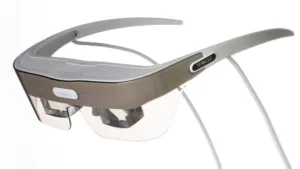Teracle, a California and Korea based start-up company, is seeking crowdfunding support for its Teraglass augmented reality headset. The campaign is running until March 3 and has so far (February 16) achieved less than half of its modest goal of $42,750. This looks like another attempt at marketing via Kickstarter rather than some real financing of development or manufacturing. According to the information from Teracle, the headset is already developed and is slated for delivery in May of 2016.
The headset features two high resolution XGA (1024×768) OLED displays. These micro OLED displays feature a pixel density of 2,560 ppi, pretty much state of the art displays, based on the specs. The key to turning such high end micro displays into a good head mounted headset is the optical system. From the look of the Teraglass, this approach is pretty much a repeat of the Google Glass approach with a thick optical combiner rod. In this case, the image is projected from the top instead of the side; however the relatively large optical combiner is concealed behind an ultra modern plastic lens. We have seen this kind of approach for years from Vuzix, resulting in less than desirable form factors.
Source: Teraglass.org
The Teraglass is offering a higher resolution than other headsets on the market; however for entertainment applications the 16:9 form factor of available content limits the device to basically a 720p resolution. For PC applications the XGA resolution results in a larger screen overall. The optics creates a virtual 86” display at a distance of 3m (roughly 10 feet). This equates to a 40 degree field of view, not bad at all.
The device itself supports hand gesture control as well as a remote control attached by cable. There is no mention of WiFi or Bluetooth, so it seems that all content will be coming to the device via a HDMI cable, so the glasses join the class of cable-attached headsets already on the market.
This will not be a stand alone device, to be used for anything, instead it seems to be a portable large screen monitor for particular applications. From a weight standpoint, the device comes in under 85g, which makes it light enough for extended use. However, shedding the weight means also that the battery only provides 4 hours of working time.
Overall, this device seems to be just another conventional augmented reality headset, without much technological differentiation from other devices and as such will have to appeal to cost sensitive buyers. The early bird special starts at $350 or $400 for the device. The education package offers 10 devices, t-shirts and sweatshirts for $10,000, which hints at a final sales price in the $1,000 range. Not cheap, but very realistic. – NH

